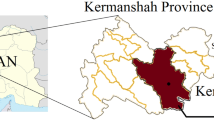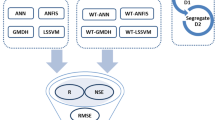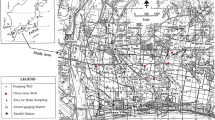Abstract
Several groundwater-level forecasting studies have shown that data-driven models are simpler, faster to develop, and provide more accurate and precise results than physical or numerical-based models. Five data-driven models were examined for the forecasting of groundwater levels as a result of recharge via tailings from an abandoned mine in Quebec, Canada, for lead times of 1 day, 1 week and 1 month. The five models are: a multiple linear regression (MLR); an artificial neural network (ANN); two models that are based on de-noising the model predictors using the wavelet-transform (W-MLR, W-ANN); and a W-ensemble ANN (W-ENN) model. The tailing recharge, total precipitation, and mean air temperature were used as predictors. The ANN models performed better than the MLR models, and both MLR and ANN models performed significantly better after de-noising the predictors using wavelet-transforms. Overall, the W-ENN model performed best for each of the three lead times. These results highlight the ability of wavelet-transforms to decompose non-stationary data into discrete wavelet-components, highlighting cyclic patterns and trends in the time-series at varying temporal scales, rendering the data readily usable in forecasting. The good performance of the W-ENN model highlights the usefulness of ensemble modeling, which ensures model robustness along with improved reliability by reducing variance.
Résumé
Plusieurs études de prévision de niveaux d’eaux souterraines ont montré que les modèles pilotés par les données sont plus simples, plus rapides à développer et fournissent des résultats plus précis que les modèles numériques à base physique. Cinq modèles pilotés par les données ont été examinés pour la prévision des niveaux piézométriques résultant de la recharge via des terrils d’une mine abandonnée au Québec, Canada, pour des temps compris entre le jour, la semaine et le mois. Les cinq modèles sont: une régression linéaire multiple (RLM); un réseau de neurones artificiels (RNA); deux modèles qui sont basés sur le débruitage des prédicteurs de modèle utilisant la transformée des ondelettes (W-RLM, W-RNA); et un modèle d’ensemble d’ondelettes et de réseaux neuronaux artificiels (W-ERNA). La recharge via le terril, les précipitations totales, et la température moyenne de l’air sont utilisés comme prédicteurs. Les modèles RNA sont plus performants que les modèles RLM, et les deux modèles RLM et RNA fournissent des résultats significativement meilleurs après avoir ôté le bruit du signal du prédicteur en utilisant les transformées d’ondelettes. Globalement, le modèle W-ERNA obtient les meilleurs résultats pour les trois horizons temporels. Ces résultats mettent en évidence la capacité des transformées d’ondelettes pour décomposer les données non stationnaires en composantes discrètes d’ondelettes, soulignant les caractéristiques et les tendances cycliques dans les séries temporelles pour les différentes échelles de temps, rendant les données facilement utilisables pour les prévisions. La bonne performance du modèle W-ERNA souligne l’utilité de la modélisation d’ensemble, qui assure la robustesse du modèle avec une fiabilité améliorée en réduisant la variance.
Resumen
Varios estudios de pronósticos de niveles de agua subterráneas muestran que los modelos controlados por datos son más simples, más rápidos para desarrollar, y proporcionan resultados más precisos y exactos que los modelos de bases físicas o numéricas. Se examinaron cinco modelos controlados por datos para el pronóstico de niveles de agua subterránea como un resultado de la recarga en la escombrera de una mina abandonada en Quebec, Canadá, para tiempos de 1 día, 2 semana y 1 mes. Los cinco modelos son: una regresión lineal múltiple (MLR); una red neuronal artificial (ANN); dos modelos que están basado en modelos predictores de eliminación de ruidos usando la transformada de wavelet (W-MLR, W-ANN); y un conjunto de W con un modelo ANN (W-ENN). Se usaron la recarga de la escombrera, la precipitación total y la temperatura media del aire como predictores. Se obtuvieron mejores resultados con los modelos ANN que con los modelos MLR, y los modelos MLR y ANN mejoraron significativamente después de la eliminación de ruidos usando transformadas de wavelet. En general, el modelo W-ENN es mejor para cada uno de los tres tiempos. Estos resultados resaltan la capacidad de las transformadas de wavelet para descomponer datos no estacionarios en componentes discretas, resaltando los patrones cíclicos y las tendencias en las series de tiempo variando las escalas temporales, haciendo que los datos sean fácilmente utilizables en el pronóstico. La buena performance de modelo W-ENN resalta la utilidad del modelado conjunto, que asegura la robustez del modelo junto con una mayor fiabilidad al reducir la varianza.
摘要
若干项地下水位预测研究显示,依照数据处理的模型比基于物理或基于数值的模型可更简单、更快速地构建,能提供更准确的结果。检验了5个预测加拿大魁北克省废弃矿山尾矿排泄后周期为一天、一周、一个月地下水位的依据数据处理的模型。5个模型是:多元线性回归模型;人工神经网络模型;两个基于采用微波转换对模型预测因子除燥的模型;及微波总体神经网络模型。尾矿排泄、总降水量和平均气温作为预测因子。人工神经网络模型比多元线性回归模型表现要好,多远线性回归模型和人工神经网络模型经过采用微波转换对预测因子除燥后效果好很多。总之,微波总体人工神经网络模型对三个周期的每个时间段预测的最好。这些结果突出了微波转换分解非稳定数据到分立微波成分中的能力,强调了不同时间尺度下时间序列中的周期模式和趋势,使数据很容易滴用于预测。微波总体人工神经网络模型的良好表现凸显了总体模拟的有用性,这种总体模拟可通过减少差异确保模型的稳健性和改进的可靠性。
Resumo
Vários estudos de previsão de níveis de águas subterrâneas têm mostrado que os modelos baseados em dados são mais simples, mais rápidos de desenvolver e fornecem resultados mais exatos e precisos do que os modelos físicos ou modelos baseados em métodos numéricos. Foram examinados cinco modelos baseados em dados, para a previsão de níveis de águas subterrâneas resultantes de recarga através dos rejeitos de uma mina abandonada no Quebec, Canadá, para prazos de resposta de 1 dia, 1 semana e 1 mês. Os cinco modelos são: uma regressão linear múltipla (MLR); uma rede neuronal artificial (ANN); dois modelos baseados na eliminação de ruído dos preditores do modelo utilizando a transformada de onduletas (W-MLR, W-ANN); e um modelo neuronal W-conjunto de onduletas ANN (W-ENN). Foram utilizados como preditores a recarga nos rejeitados mineiros, a precipitação total e a temperatura média do ar. Os modelos ANN tiveram melhor desempenho do que os modelos MLR, e ambos os modelos MLR e ANN tiveram um desempenho significativamente melhor após a redução de ruído dos preditores utilizando transformadas de onduletas. Em geral, o modelo W-ENN gerou melhores resultados para cada um dos três prazos de resposta. Os resultados destacam a capacidade das transformadas de onduletas de decompor dados não estacionários em componentes discretos de onduletas, destacando padrões cíclicos e tendências nas séries temporais nas diferentes escalas temporais, tornando os dados imediatamente utilizáveis na previsão. O bom desempenho do modelo W-ENN põe em evidência a utilidade da modelação conjunta, que garante a robustez do modelo a par de uma fiabilidade acrescida, através da redução da variância.















Similar content being viewed by others
References
Adamowski J (2008) Development of a short-term river flood forecasting method for snowmelt driven floods based on wavelet and cross-wavelet analysis. J Hydrol 53(3–4):247–266
Adamowski J, Chan HF (2011) A wavelet neural network conjunction model for groundwater level forecasting. J Hydrol 407(1–4):28–40
Adamowski J, Sun K (2010) Development of a coupled wavelet transform and neural network method for flow forecasting of non-perennial rivers in semi-arid watersheds. J Hydrol 390(1–2):85–91
Agrafiotis DK, Cedeno W, Lobanov VS (2002) On the use of neural network ensembles in QSAR and QSPR. J Chem Inf Comput Sci 42:903–911
Ahn H (2000) Modeling of groundwater heads based on second-order difference time series models. J Hydrol 234(1):82–94
Ahn H, Salas JD (1997) Groundwater head sampling based on stochastic analysis. Water Resour Res 33(12):2769–2780
Anderson JA (1995) An introduction to neural networks. MIT, Cambridge, MA
Banerjee P, Prasad RK, Singh VS (2009) Forecasting of groundwater level in hard rock region using artificial neural network. Environ Geol 58(6):1239–1246
Banerjee P, Sing VS, Chattopadhyay K, Chandra PC, Singh B (2011) Artificial neural network model as a potential alternative for groundwater salinity forecasting. J Hydrol 398:212–220
Bidwell VJ (2005) Realistic forecasting of groundwater level, based on the eigenstructure of aquifer dynamics. Math Comput Simul 69(1):12–20
Breiman L (1996) Bagging predictors. Mach Learn 24:123–140
Broda S, Aubertin M, Blessent D, Maqsoud A, Bussière B (2014) Simulating the variation of the phreatic surface level to assess reclamation techniques for an acidic tailings impoundment: a field-scale study. GeoRegina2014: Engineering for the Extremes, 67th CGS conference, Regina, SK, Canada, September 2014, 7 pp
Burke LI, Ignizio JP (1992) Neural networks and operations research: an overview. Comput Oper Res 19:179–189
Burney SM, Jilani TA, Ardil C (2004) A comparison of first and second order training algorithms for artificial neural networks. In: Proceedings of the International Conference on Computational Intelligence, Istanbul, December 2004
Coppola E, Szidarovszky F, Poulton M, Charles E (2003) Artificial neural network approach for predicting transient water levels in a multilayered groundwater system under variable state, pumping, and climate conditions. J Hydrol Eng 8:348–360
Coulibaly P, Anctil F (1999) Real time short term natural waters inflow forecasting using recurrent neural networks. In: Proceedings of International Joint Conference on Neural Networks, 1999, IJCNN ’99, vol 6, IEEE Press, Piscataway, NJ, pp 3802– 3805
Coulibaly P, Anctil F, Bobée B (2000) Daily reservoir inflow forecasting using artificial neural networks with stopped training approach. J Hydrol 230:244–257
Daliakopoulos IN, Coulibaly P, Tsanis IK (2005) Groundwater level forecasting using artificial neural networks. J Hydrol 309(1):229–240
Dietterich TG (2000) An experimental comparison of three methods for constructing ensembles of decision trees: bagging, boosting and randomization. Mach Learn 40:139–157
Ding H, Liu D, Zhao FF (2010) Variation trend analysis of groundwater depth in area of well irrigation in Sanjiang Plain based on wavelet neural network. In: Advances in neural network research and applications. Springer, Heidelberg, pp 829–836
Efron B, Tibshirani R (1993) An introduction to the bootstrap. Chapman and Hall, London
Environment Canada (2013) Climate data of the Val-d’Or meteorological station. Environment Canada. http://climate.weather.gc.ca. Accessed 20 September 2013
Faraway J, Chatfield C (1998) Time series forecasting with neural networks: a comparative study using the airline data. Appl Stat 47(2):231–250
Farias CAS, Suzuki K, Kadota A (2009) Sequential prediction of daily groundwater levels by a neural network model based on weather forecasts. In: Advances in water resources and hydraulic engineering. Springer, Heidelberg, pp 225–230
Fortin V, Ouarda TBMJ, Bobée B (1997) Comment on ‘The use of artificial neural networks for the prediction of water quality parameters’ by H.R. Maier and G.C. Dandy. Water Resour Res 33(10):2423–22424
Ghose DK, Panda SS, Swain PC (2010) Prediction of water table depth in western region, Orissa using BPNN and RBFN neural networks. J Hydrol 394(3):296–304
Hagan MT, Menhaj M (1994) Training feedforward networks with the Marquardt algorithm. IEEE Trans Neural Netw 5(6):989–993
Helsel DR, Hirsch RM (2002) Statistical methods in water resources. Elsevier, Amsterdam, 522 pp
Hodgson FD (1978) The use of multiple linear regression in simulating ground water level responses. Groundwater 16(4):249–253
Jasmin I, Murali T, Mallikarjuna P (2010) Statistical analysis of groundwater table depths in upper Swarnamukhi River basin. J Water Resour Prot 2(6):577–584
Khalil B, Ouarda TBMJ, St-Hilaire A (2011) Estimation of water quality characteristics at ungauged sites using artificial neural networks and canonical correlation analysis. J Hydrol 405:277–287
Khalil B, Awadallah AG, Karaman H, El-Sayed A (2012) Application of artificial neural networks for the prediction of water quality variables in Nile Delta. J Water Resour Prot 4(6):388–394
Khalil B, Adamowski J (2014) Comparison of OLS, ANN, KTRL, KTRL2, RLOC, and MOVE as record-extension techniques for water quality variables. Water Air Soil Pollut 225(6):1966
Kim TW, Valdés JB (2003) Nonparametric approach for estimating return periods of droughts in arid regions. J Hydrol Eng 8(5):237–246
Krishna B, Satyaji Rao YR, Vijaya T (2008) Modelling groundwater levels in an urban coastal aquifer using artificial neural networks. Hydrol Process 22(8):1180–1188
Lallahem S, Mania J, Hani A, Najjar Y (2005) On the use of neural networks to evaluate groundwater levels in fractured media. J Hydrol 307(1):92–111
Maier HR, Dandy GC (2001) Neural network based modelling of environmental variables: a systematic approach. Math Comput Model 33:669–682
Mallat SG (1999) A wavelet tour of signal processing, 2nd edn. Academic, London
Maskey S, Dibike YB, Jonoski A, Solomatine D (2000) Groundwater model approximation with artificial neural network for selecting optimum pumping strategy for plume removal. International Institute for Infrastructural, Hydraulic and Environmental Engineering, Delft, The Netherlands
Merz CJ (1998) Classification and regression by combining models. PhD Thesis. Univ. of California, Irvine, CA, USA
Mohammadi K (2008) Groundwater table estimation using MODFLOW and artificial neural networks. In: Practical hydroinformatics. Springer, Heidelberg, pp 127–138
Mohanty S, Jha MK, Kumar A, Sudheer KP (2010) Artificial neural network modeling for groundwater level forecasting in a River Island of eastern India. Water Resour Manag 24(9):1845–1865
Mohanty S, Jha MK, Kumar A, Panda DK (2013) Comparative evaluation of numerical model and artificial neural network for simulating groundwater flow in Kathajodi Surua inter-basin of Odisha, India. J Hydrol 495:38–51
Moon YI, Rajagopalan B, Lall U (1995) Estimation of mutual information using kernel density estimators. Phys Rev E 52(3):2318–2321
Moosavi V, Vafakhah M, Shirmohammadi B, Behnia N (2013) A wavelet-ANFIS hybrid model for groundwater level forecasting for different prediction periods. Water Resour Manag 27(5):1301–1321
Murtagh F, Starck JL, Renaud O (2004) On neuro-wavelet modeling. Decis Support Syst 37:475–484
Nayak PC, Rao YS, Sudheer KP (2006) Groundwater level forecasting in a shallow aquifer using artificial neural network approach. Water Resour Manag 20(1):77–90
Nayak PC, Venkatesh B, Krishna B, Jain SK (2013) Rainfall-runoff modelling using conceptual, data driven, and wavelet based computing approach. J Hydrol 493:57–67
Nikolos IK, Stergiadi M, Papadopoulou MP, Karatzas GP (2008) Artificial neural networks as an alternative approach to groundwater numerical modelling and environmental design. Hydrol Process 22:3337–3348
Opitz D, Maclin R (1999) Popular ensemble methods: an empirical study. J Artif Intell Res 11:169–198
Ouangrawa M, Aubertin M, Molson JW, Bussière B, Zagury GJ (2010) Preventing acid mine drainage with an elevated water table: long-term column experiments and parameter analysis. Water Air Soil Pollut 213:437–458
Ouarda TBMJ, Shu C (2009) Regional low-flow frequency analysis using single and ensemble artificial neural networks. Water Resour Res 45, W11428. doi:10.1029/2008WR007196
Partal T, Cigizoglu K (2008) Estimation and forecasting of daily suspended sediment data using wavelet-neural networks. J Hydrol 358(3–4):317–331
Partal T, Kisi O (2007) Wavelet and neuro-fuzzy conjunction model for precipitation forecasting. J Hydrol 342(1–2):199–212
Perez-Valdivia C, Sauchyn D (2011) Tree-ring reconstruction of groundwater levels in Alberta, Canada: long term hydroclimatic variability. Dendrochronologia 29(1):41–47
Ramana RV, Krishna B, Kumar SR, Pandey NG (2013) Monthly rainfall prediction using wavelet neural network analysis. Water Resour Manag 27:3697–3711
Rumelhart DE, McClelland JL (1986) Parallel distributed processing: explorations in the microstructure of cognition, foundations, vol 1. MIT Press, Cambridge
Schapire RE (1990) The strength of weak learnability. Mach Learn 5:197–227
Serinaldi F, Grimaldi S, Abdolhosseini M, Corona P, Cimini D (2012) Testing copula regression against benchmark models for point and interval estimation of tree wood volume in beech stands. Eur J For Res 131(5):1313–1326
Sethi RR, Kumar A, Sharma SP, Verma HC (2010) Prediction of water table depth in a hard rock basin by using artificial neural network. Int J Water Resour Environ Eng 2(4):95–102
Sharkey AJC (1999) Combining artificial neural nets: ensemble and modular multi-net systems. Springer, London
Shensa MJ (1992) Discrete wavelet transforms: wedding the a Trous and Mallat algorithms. IEEE T Signal Process 40:2464–2482
Shirmohammadi B, Vafakhah M, Moosavi V, Moghaddamnia A (2013) Application of several data-driven techniques for predicting groundwater level. Water Resour Manag 27(2):419–432
Shu C, Burn DH (2004) Artificial neural network ensembles and their application in pooled flood frequency analysis. Water Resour Res 40, W09301. doi:10.1029/2003WR002816
Shu C, Ouarda TBMJ (2007) Flood frequency analysis at ungauged sites using artificial neural networks in canonical correlation analysis physiographic space. Water Resour Res 43, W07438. doi:10.1029/2006WR005142
Sreekanth PD, Geethanjali N, Sreedevi PD, Ahmed S, Kumar NR, Jayanthi PK (2009) Forecasting groundwater level using artificial neural networks. Curr Sci 96(7):933–939
Swee EGT, Elangovan S (1999) Applications of symmlets for denoising and load forecasting. Proceedings of the IEEE Signal Processing Workshop on Higher-Order Statistics, IEEE Computer Society, Piscataway, NJ, pp 165–169
Taormina R, Chau KW, Sethi R (2012) Artificial neural network simulation of hourly groundwater levels in a coastal aquifer system of the Venice lagoon. Eng Appl Artif Intell 25(8):1670–1676
Tiwari MK, Chatterjee C (2011) A new wavelet–bootstrap–ANN hybrid model for daily discharge forecasting. J Hydroinform. doi:10.2166/hydro.2010.142
Tsanis I, Coulibaly P, Daliakopoulos I (2008) Improving groundwater level forecasting with a feedforward neural network and linearly regressed projected precipitation. J Hydroinform 10(4):317–330
Uddameri V (2007) Using statistical and artificial neural network models to forecast potentiometric levels at a deep well in South Texas. Environ Geol 51(6):885–895
Wolpert DH (1992) Stacked generalization. Neural Netw 5:241–259
Yoon H, Jun SC, Hyun Y, Bae GO, Lee KK (2011) A comparative study of artificial neural networks and support vector machines for predicting groundwater levels in a coastal aquifer. J Hydrol 396(1):128–138
Zaier I, Shu C, Ouarda TBMJ, Seidou O, Chebana F (2010) Estimation of ice thickness on lakes using artificial neural networks ensembles. J Hydrol 380:330–340
Zhang SP, Watanabe H, Yamada R (1994) Prediction of daily water demand by neural networks. In: Hipel KW et al (eds) Stochastic and statistical methods in hydrology and environmental engineering, vol 3. Springer, New York, pp 217–227
Zheng G, Starck JL, Campbell JG, Murtagh F (1999) Multiscale transforms for filtering financial data streams. J Comput Intell Finan 7:18–35
Acknowledgements
Financial support provided by “Le Fonds de recherche du Québec – Nature et technologies” held by Dr. Bahaa Khalil is acknowledged. An NSERC Discovery Grant held by Jan Adamowski was also used to partially fund this research. Further, the authors are grateful for the financial support of the partners of the Industrial NSERC Polytechnique-UQAT Chair on Environment and Mine Wastes Management and the UQAT-Polytechnique Research Institute on Mining and the Environment. The authors would also like to thank A. Maqsoud (UQAT) for the field data collection.
Author information
Authors and Affiliations
Corresponding author
Rights and permissions
About this article
Cite this article
Khalil, B., Broda, S., Adamowski, J. et al. Short-term forecasting of groundwater levels under conditions of mine-tailings recharge using wavelet ensemble neural network models. Hydrogeol J 23, 121–141 (2015). https://doi.org/10.1007/s10040-014-1204-3
Received:
Accepted:
Published:
Issue Date:
DOI: https://doi.org/10.1007/s10040-014-1204-3




